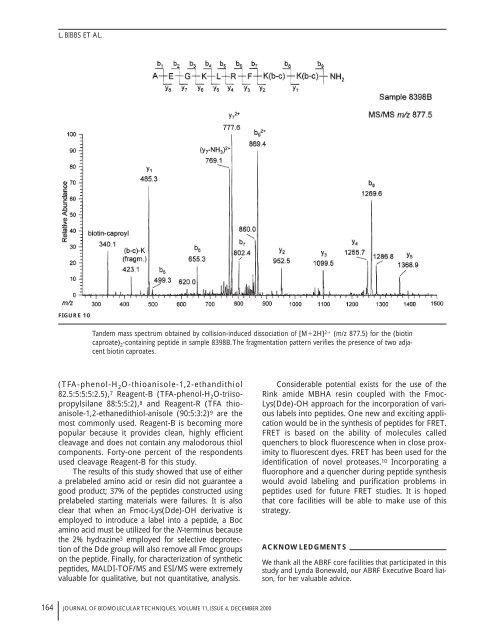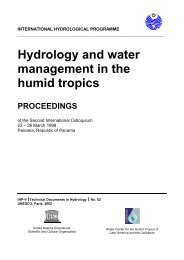FR AB - Science Reference
FR AB - Science Reference
FR AB - Science Reference
Create successful ePaper yourself
Turn your PDF publications into a flip-book with our unique Google optimized e-Paper software.
L. BIBBS ET AL.<br />
FIGURE 10<br />
Tandem mass spectrum obtained by collision-induced dissociation of [M�2H] 2� (m/z 877.5) for the (biotin<br />
caproate) 2 -containing peptide in sample 8398B.The fragmentation pattern verifies the presence of two adjacent<br />
biotin caproates.<br />
(TFA-phenol-H 2 O-thioanisole-1,2-ethandithiol<br />
82.5:5:5:5:2.5), 7 Reagent-B (TFA-phenol-H 2 O-triisopropylsilane<br />
88:5:5:2), 8 and Reagent-R (TFA thioanisole-1,2-ethanedithiol-anisole<br />
(90:5:3:2) 9 are the<br />
most commonly used. Reagent-B is becoming more<br />
popular because it provides clean, highly efficient<br />
cleavage and does not contain any malodorous thiol<br />
components. Forty-one percent of the respondents<br />
used cleavage Reagent-B for this study.<br />
The results of this study showed that use of either<br />
a prelabeled amino acid or resin did not guarantee a<br />
good product; 37% of the peptides constructed using<br />
prelabeled starting materials were failures. It is also<br />
clear that when an Fmoc-Lys(Dde)-OH derivative is<br />
employed to introduce a label into a peptide, a Boc<br />
amino acid must be utilized for the N-terminus because<br />
the 2% hydrazine 3 employed for selective deprotection<br />
of the Dde group will also remove all Fmoc groups<br />
on the peptide. Finally, for characterization of synthetic<br />
peptides, MALDI-TOF/MS and ESI/MS were extremely<br />
valuable for qualitative, but not quantitative, analysis.<br />
164 JOURNAL OF BIOMOLECULAR TECHNIQUES, VOLUME 11, ISSUE 4, DECEMBER 2000<br />
Considerable potential exists for the use of the<br />
Rink amide MBHA resin coupled with the Fmoc-<br />
Lys(Dde)-OH approach for the incorporation of various<br />
labels into peptides. One new and exciting application<br />
would be in the synthesis of peptides for <strong>FR</strong>ET.<br />
<strong>FR</strong>ET is based on the ability of molecules called<br />
quenchers to block fluorescence when in close proximity<br />
to fluorescent dyes. <strong>FR</strong>ET has been used for the<br />
identification of novel proteases. 10 Incorporating a<br />
fluorophore and a quencher during peptide synthesis<br />
would avoid labeling and purification problems in<br />
peptides used for future <strong>FR</strong>ET studies. It is hoped<br />
that core facilities will be able to make use of this<br />
strategy.<br />
ACKNOWLEDGMENTS<br />
We thank all the <strong>AB</strong>RF core facilities that participated in this<br />
study and Lynda Bonewald, our <strong>AB</strong>RF Executive Board liaison,<br />
for her valuable advice.















